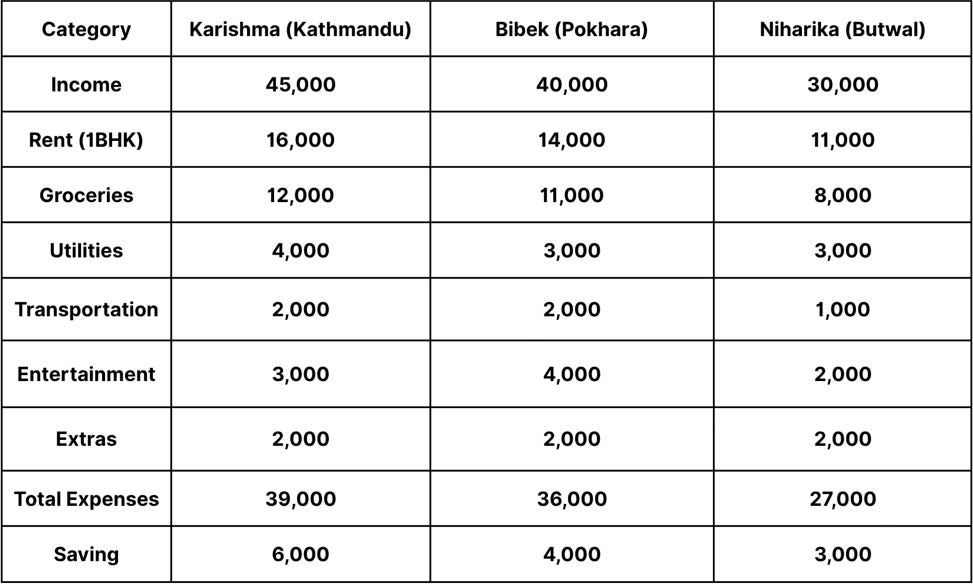From rent and inflation to career trade-offs and inner doubts, we follow three lives across three cities to uncover the true price of living in urban Nepal.
By the second week of every month, most wallets in Nepal start coughing. Rent’s due. Fridge’s empty. Balance is low & even momo feels like a luxury. So how far does a paycheck actually go in Nepal’s cities? Let’s see what life looks like through three different people living in three very different places.
Karishma lives in Kathmandu. She’s in her late twenties and works at an INGO. Her morning starts with traffic jams and the day ends with burnout. Meanwhile, Bibek is in Pokhara. He runs a small trekking agency. His income is like the weather of Pokhara-some days sunny, the next day stormy. Over in Butwal, Niharika teaches at a private school. Her life is calm here, maybe a little too calm, because so is her career growth. They live differently, but they all think hard about how they spend.
Here’s a closer look at what their monthly expenses actually look like.

The cost of living isn’t always measured in rent or salary. Sometimes, it’s the slower career growth, skipped dinners, and the peace exchanged for hustle. For Karishma, Bibek, and Niharika, each city came with its own silent sacrifice and those compromises still shape their lives.
Karishma didn’t move to Kathmandu just for a job–she moved for career growth. The city gave her a purpose, and connections that made her feel seen and important. But somewhere between Ring Road traffic jams and late-night Pathao food orders, something quietly slipped away. Sunsets and silence are luxuries she no longer has. She says “I came here to grow but sometimes I feel like I’m fading.” Kathmandu gave her career growth but took mornings with family and the calm of home.
While, Bibek wakes up on his own time, reads when he feels like it, and enjoys tea by the lake. He left Kathmandu’s endless job interviews chasing freedom–but freedom brought him uncertainty. Some weeks are flush with tourists while the others he’s counting coins. He says “I escaped the 9-to-5 but didn’t realize I was trading clarity for calm.” Pokhara gives him peace, but costs his career momentum.
Meanwhile, Niharika has time. She walks to work and shares meals with her family. Her days are familiar, maybe too familiar. There’s comfort in Butwal’s predictability, but with each birthday, a quiet question rises on her mind: “What else is out there?” She wants to chase bigger dreams but worries, “What if I fall behind?” Butwal feels safe, but that safety might be holding her back.
So What’s the Cost?
Karishma chooses growth. Bibek chooses freedom. Niharika chooses peace.
Each one gave up something. Sometimes the cost is money. Sometimes it’s time. Sometimes it’s a version of yourself you never became.
And every now and then, they wonder- “What if I had lived somewhere else?”
Each choice comes with a price, shaped not just by personal sacrifice but by the unique challenges of the cities they live in. Let’s explore how Kathmandu, Pokhara, and Butwal tell very different economic stories–and how those stories shape lives like Karishma’s, Bibek’s, and Niharika’s.
Kathmandu pulses with opportunity. It’s the heartbeat of Nepal’s economy, run by NGOs, banks, tech and corporate bustle. Karishma, like many, came here chasing career growth. She knows this city offers the biggest stage to rise but it demands a price. Inflation here doesn’t wait. Rent climbs, lunches cost more, groceries and even momo have gotten dearer. Official inflation might say 2.64% as of mid May 2025, but on the ground, it feels more like double. Karishma’s salary grows too, but never quite fast enough to keep pace. She earns more than most of her friends back home. But every raise is a reminder that more money means more expenses. Kathmandu pulls thousands like Karishma every year. Some make it big, some get lost in the rush. She’s somewhere in between-moving forward, but running on empty.
Bibek’s world revolves around the hills and tourism. His income depends on the season. When tourists flood in, work is steady. When they leave, the months stretch long. About 58% of Pokhara’s economy depends on tourism-meaning october feels abundant while february feels sparse. Inflation here is a bit kinder–2.23% but when weeks pass without earnings, even stable prices feel heavy. Bibek makes good money some months; other times, he’s counting change. He jokes that his salary fluctuates more than the weather of pokhara. After years in Kathmandu’s chaos, Bibek chose calm. Slowly, others are returning to Pokhara too–seeking fresh air and space.
Niharika lives where life moves slower. Butwal’s economy runs on trade, agriculture, transport, and steady local shops. There’s no boom here, no crash-just steady, quiet rhythm. Inflation is the lowest among the three cities at 2.15%. Prices barely budge. Groceries and rent have stayed nearly the same for years. Her wages are lower than friends in Kathmandu, but so are her expenses. She doesn’t stress about gas, food, or weekend plans. Her needs are met, and meals are still home-cooked. Her brother left for Korea. Her cousin moved to Kathmandu. Niharika stayed not because she couldn’t leave, but because she didn’t want to chase a city that might never slow down for her.
Maybe the real cost of living isn’t just about money. It’s the energy we spend pretending we’re fine. The time we trade for someone else’s deadline. The dreams we shelve “for later” that never comes.
So the question isn’t just “Where is it cheaper to live?”
It’s, Where does your life feel most like your own?
So, what’s your dream city to live in Nepal?
